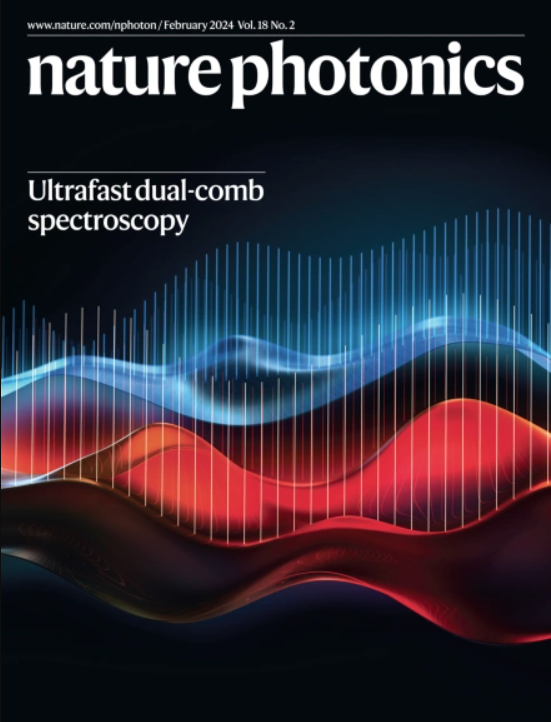通过聚合物异质界面桥提高钙钛矿太阳能电池的效率和稳定性
IF 32.9
1区 物理与天体物理
Q1 OPTICS
引用次数: 0
摘要
缺陷和机械弱界面严重破坏了钙钛矿太阳能电池(PSCs)的效率和稳定性。在这里,我们介绍了一种线性聚合物,肝素钠,作为n-i-p psc中的多功能界面桥接层。与常用的小分子界面改性/钝化材料不同,肝素钠的官能团和离子包括COO−、SO3−和Na+分布在其主链的上下两侧。因此,它通过牢固的化学键连接SnO2电子传输层和钙钛矿膜,减轻了psc中的缺陷并增强了异质界面键合。由此产生的刚性器件的功率转换效率(PCE)为26.61%(认证为26.54%),使其成为效率最高的psc之一。我们还制造了柔性的SnO2/肝素钠基PSCs, PCE达到25.23%。肝素钠基器件表现出良好的操作稳定性和热稳定性。在模拟的1-太阳条件下,在最大功率点跟踪1800小时后,初始PCE的94.9%被保留。在85°C下老化1800小时后,这些设备还能保持95.2%的初始PCE。本文章由计算机程序翻译,如有差异,请以英文原文为准。


Enhancing the efficiency and stability of perovskite solar cells via a polymer heterointerface bridge
Defective and mechanically weak interfaces substantially undermine both the efficiency and stability of perovskite solar cells (PSCs). Here we introduce a linear polymer, heparin sodium, as a multifunctional interface bridge layer in n–i–p PSCs. Unlike commonly employed small-molecule interface modification/passivation materials, heparin sodium features functional groups and ions including COO−, SO3− and Na+ distributed along the top and bottom sides of its backbone. It thus serves as a bridge connecting the SnO2 electron transport layer and the perovskite film through robust chemical bonding, mitigating defects and enhancing heterointerface bonding in PSCs. The power conversion efficiency (PCE) of the resulting rigid devices is 26.61% (certified 26.54%), positioning it among the highest-efficiency PSCs. We also fabricate flexible SnO2/heparin sodium-based PSCs that achieve a PCE of 25.23%. The heparin sodium-based devices demonstrate excellent operational and thermal stability. After 1,800 h under maximum power point tracking under simulated 1-Sun conditions, 94.9% of the initial PCE is retained. The devices also maintain 95.2% of their initial PCE after ageing at 85 °C for 1,800 h. The introduction of sodium heparin passivates interface defects and enhances bonding between the electron transport layer and the perovskite layer in perovskite solar cells. The best-performing devices exhibit a certified PCE of 26.54% and maintain almost 95% of their initial performance after 1,800 h of maximum power point tracking.
求助全文
通过发布文献求助,成功后即可免费获取论文全文。
去求助
来源期刊

Nature Photonics
物理-光学
CiteScore
54.20
自引率
1.70%
发文量
158
审稿时长
12 months
期刊介绍:
Nature Photonics is a monthly journal dedicated to the scientific study and application of light, known as Photonics. It publishes top-quality, peer-reviewed research across all areas of light generation, manipulation, and detection.
The journal encompasses research into the fundamental properties of light and its interactions with matter, as well as the latest developments in optoelectronic devices and emerging photonics applications. Topics covered include lasers, LEDs, imaging, detectors, optoelectronic devices, quantum optics, biophotonics, optical data storage, spectroscopy, fiber optics, solar energy, displays, terahertz technology, nonlinear optics, plasmonics, nanophotonics, and X-rays.
In addition to research papers and review articles summarizing scientific findings in optoelectronics, Nature Photonics also features News and Views pieces and research highlights. It uniquely includes articles on the business aspects of the industry, such as technology commercialization and market analysis, offering a comprehensive perspective on the field.
 求助内容:
求助内容: 应助结果提醒方式:
应助结果提醒方式:


